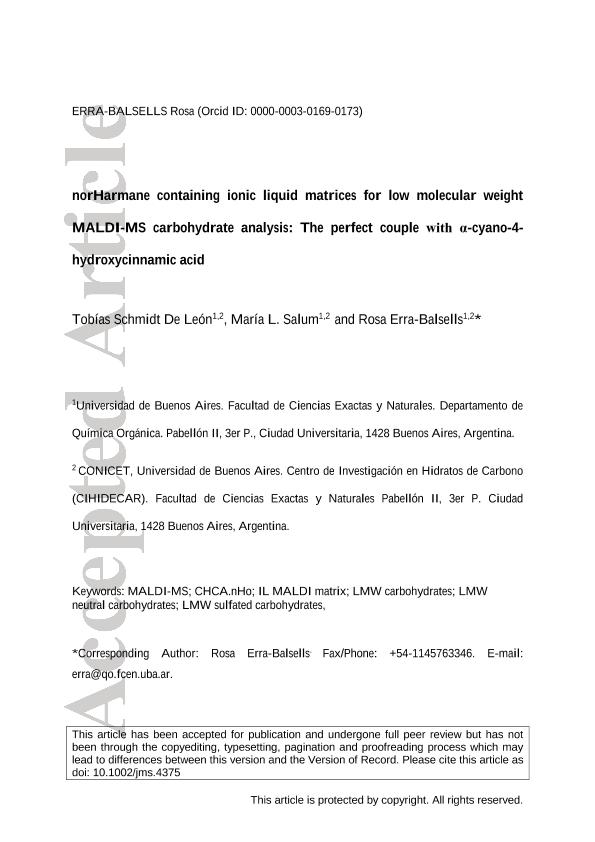Artículo
NorHarmane containing ionic liquid matrices for low molecular weight MALDI-MS carbohydrate analysis: The perfect couple with α-cyano-4-hydroxycinnamic acid
Fecha de publicación:
05/2019
Editorial:
John Wiley & Sons Ltd
Revista:
Journal of Mass Spectrometry
ISSN:
1076-5174
Idioma:
Inglés
Tipo de recurso:
Artículo publicado
Clasificación temática:
Resumen
Cinnamic acid derivatives, particularly α-cyano-4-hydroxycinnamic acid (E-α-cyano-4-hydroxycinnamic acid or (E)-2-cyano-3-(4-hydroxyphenyl)prop-2-enoate; CHCA), have been extensively used especially for protein and peptide analysis. Together with the introduction of ionic liquid MALDI matrix (ILM) started the study of applications of IL prepared with CHCA and a counter organic base (ie, aliphatic amines) in which CHCA moiety is the chromophore responsible of UV-laser absorption. Despite the extensive studies of norharmane (9H-pyrido[3,4-b]indole; nHo) applications as matrix and its peculiar basic properties in the ground and electronic excited state, nHo containing ILM was never tested in MALDI-MS experiments. This pyrido-indole compound was introduced as MALDI matrix 22 years ago for different applications including low molecular weight (LMW) carbohydrates (neutral, acidic, and basic carbohydrates). These facts encouraged us to use it as a base, for the first time, for ILM preparation. As a rational design of new IL MALDI matrices, E-α-cyanocinnamic acid.nHo and E-cinnamic acid.nHo were prepared and their properties as matrices studied. Their performance was compared with that of (a) the corresponding IL prepared with butylamine as basic component, (b) the corresponding crystalline E-α-cyanocinnamic and E-cinnamic acid, and (c) the classical crystalline matrices (2,5-dihydroxybenzoic acid, DHB; nHo) used in the analysis of neutral/sulfated carbohydrates. The IL DHB.nHo was tested, too. Herein, we demonstrate the outstanding performance for the IL CHCA.nHo for LMW carbohydrate in positive and negative ion mode (linear and reflectron modes). Sulfated oligosaccharides were detected in negative ion mode, and although the dissociation of sulfate groups was not completely suppressed the relative intensity (RI) of [M − Na]− peak was quite high. Additionally, to better understand the quite different performance of each IL tested as matrix, the physical and morphological properties in solid state were studied (optical image; MS image).
Archivos asociados
Licencia
Identificadores
Colecciones
Articulos(CIHIDECAR)
Articulos de CENTRO DE INVESTIGACIONES EN HIDRATOS DE CARBONO
Articulos de CENTRO DE INVESTIGACIONES EN HIDRATOS DE CARBONO
Citación
Schmidt de León, Tobías; Salum, Maria Laura; Erra Balsells, Rosa; NorHarmane containing ionic liquid matrices for low molecular weight MALDI-MS carbohydrate analysis: The perfect couple with α-cyano-4-hydroxycinnamic acid; John Wiley & Sons Ltd; Journal of Mass Spectrometry; 54; 7; 5-2019; 643-654
Compartir
Altmétricas




